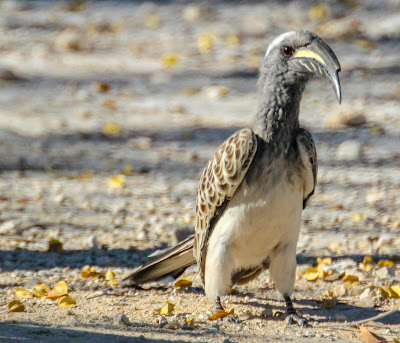Okay, I've been struggling with grey vs. gray. I realize that gray is the preferred American spelling and grey is the preferred British spelling, so does that make Wikipedia predominantly British? Or do the British dominate birds? Because whenever I see an article on Wikipedia about grey herons or grey hornbills, they all spell grey in the British way. For my blog, at least for this one, I'll use grey, but I'm struggling with it.
We saw this African grey hornbill in Halili Camp in Etosha NP in Namibia. We were in our vehicle and it was outside on the ground. I'd only ever seen red or yellow hornbills before and I wasn't sure what to make of this. I thought it might be a juvenile. When we got to Hwange NP in Zimbabwe our guide showed us some grey hornbills, but I didn't get any good pictures of them. So I'm happy to see that some of these photos turned out. I sat in the vehicle and took quite a few pictures of this guy.
It has an interesting distribution. It is found in a band across Sub-Saharan Africa, then goes south near the eastern coast of Africa, then bands again across a portion of southern Africa.
This bird's bill was throwing me fits. I couldn't tell what it was. It looked like maybe the bill was always open and that perhaps the bill on top was not long enough to cover the bill on the bottom. So I had to do some close-ups to really figure out what was going on. Weird.
 |
| This bird has its bill open. It looks serrated. Crazy. |
It has a white line down each side of the head.
 |
| The white line on the side of the head here is quite prominent. |
The curved bill is black, has a creamy horizontal stripe and a small casque (a hard structure on the head of some birds).
 |
| I assume the casque is the long knob across the top of the bill. The horizontal stripe looks almost yellow. The lower mandible has the same color back-slash stripes going across it. |
The male has a black bill and the female, which is prettier, has some red on the bill. This is obviously a male. It is supposed to have grey plumage, but this one seems to have brown and white feathers on the back and white plumage on the belly.
I have fallen in love with the hornbills. This is a cool bird.




Spelling has so many grey areas. Or is that gray? Love this bird. It reminds me of a strutting member of British Parliament. So formal and stiff.
ReplyDelete